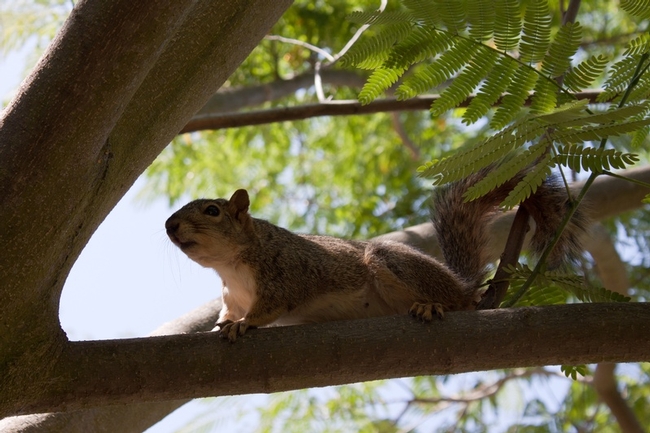Advice From MGCC's Help Desk: Thank you for contacting the Master Gardener help desk. Squirrels are very likely the culprits. They frequently chew bark on a wide variety of trees and shrubs to get at the sweet sap running just below the bark. This usually happens in the spring. The sap, running in what is called the phloem, contains nutrients made by the leaves that are being transported to other parts of the plant. The bark is the "skin" covering this vascular system. 
Here is a link to information from the University of California on tree squirrel management: http://www.ipm.ucdavis.edu/PMG/PESTNOTES/pn74122.html. You will find a section that talks about exclusion, which is almost impossible in trees, but is really the only non-lethal method for keeping squirrels out of an area. While there are many squirrel repellents on the market (many licensed for use in California), they are not particularly effective. Also, tree squirrels become acclimated to sound and lights, so these don't work as deterrents, either. The information also talks about trapping and killing squirrels, but another squirrel may move into the open territory and continue the damage. It is not legal in California to trap and relocate squirrels (or any other animals).
One possible solution to prevent the squirrels from eating the tree bark might be to use a motion-sensing water sprinkler (for example http://amzn.to/1IgUT3V)) aimed at where the squirrels access the tree. Squirrels don't like water, so this may work to keep them away. You should only need this in the spring and early summer while the sap is most attractive. Another possible solution is that if the only access to the tree is up the main trunk you might consider a sheet metal wrap of the main trunk covering at least 18", but it won't work if the squirrels can bypass by jumping from the ground or another source (fence, etc.)... and it wouldn't look too great (maybe paint it?).
Good luck!
Master Gardeners of Contra Costa Help Desk
Note: The Master Gardeners of Contra Costa's Help Desk is available year-round to answer your gardening questions. Except for a few holidays, we're open every week, Monday through Thursday for walk-ins from 9:00 am to Noon at 75 Santa Barbara Road, 2d Floor, Pleasant Hill, CA 94523. We can also be reached via telephone: (925) 646-6586, email: ccmg@ucanr.edu, or on the web at http://ccmg.ucanr.edu/Ask_Us/